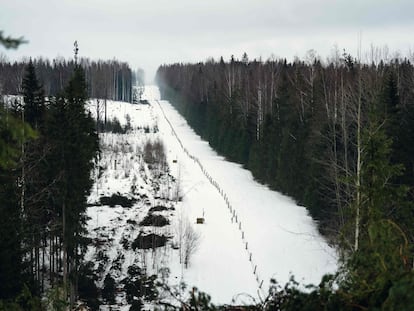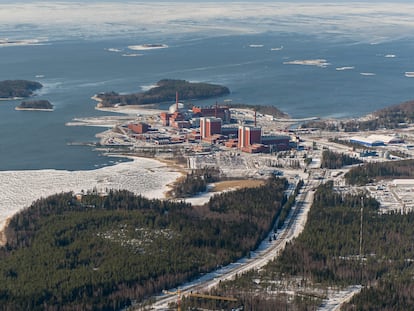Finland’s long road to NATO
Russia’s attack on Ukraine in 2022 revived memories of 1939 and was the catalyst that led the Nordic country to request definitive entry into the Alliance to increase its security

On Tuesday, 4 April 2023 Finland joined NATO. As a result, it now enjoys protection through its members’ collective defence obligations under Article 5 of the Washington Treaty and America’s nuclear deterrent. Finland’s most significant contribution to NATO, in turn, “is built on the security and defence of our own territory” said President Sauli Niinistö, adding: “In this respect, the Finnish concept of comprehensive security retains its value. But,” he emphasised, “we no longer do this work alone.” It is a mutually reinforcing relationship.
Overall, Finland’s membership of NATO highlights a profound geopolitical change in Europe – at the time when Russia’s War of conquest, which triggered Finland’s desire to cash in its “NATO option” in the first place, continues to rage in Ukraine.
It marks also a historical turning point. Coincidentally, the Finns’ accession fell on a special day in Brussels: the 74th anniversary of the formation of the Atlantic Alliance, a proof of NATO’s staying power. For Finland, meanwhile, that date now reflects liberation from the historical trauma of an imposed neutrality after World War Two.
After all, in 2022-23 this small Nordic state on Europe’s north-eastern flank, that has been an EU member since 1995, exercised the right to freely choose its alliance membership under the principle of sovereign equality of states, as enshrined in the UN Charter. In this way, it also completed its long road to fully integrate – politically and militarily – in the so-called “institutional West.”
That warm, sunny Tuesday of April 4th with winter’s snow almost thawed, will be etched in the Finnish people’s minds. You could see the real joy on people’s faces, while a sense of liberation and confidence was palpable on the Helsinki streets. A new era had begun.
Yet why does NATO membership now mean so much, considering that Finland had managed so successfully for over seven decades – with their policy of non-alignment, their confidence in self-defense, and their focus on predictability though dialogue, trade and trust building in relations with Moscow?
In 1949, Finland had deeply felt the pains of World War II, during which they had fought two separate wars against the USSR: the 1939-1940 Winter War in which they resisted Soviet invasion for 105 days, and the Continuation War of 1941-1944 in which as co-belligerents with the Nazis, Finns hoped to regain the territories ceded to the USSR in the 1940 Moscow Peace Treaty. Hostilities between Finland and the Soviet Union finally ended with the signing of the Moscow Armistice of 1944, with one of the conditions being the disarming and expulsion of Germans troops from Finnish territory (which led to the Lapland War between Finland and Germany in 1945).
World War II was concluded formally for Finland and the minor Axis powers with the signing of the Paris Peace treaties in 1947. But with it came the irrevocable territorial losses of Karelia, Salla, and Petsamo in the Far North with its nickel mines and ports on the Barents Sea coast, and the leasing in the South of the Porkkala naval base to the Soviets. Furthermore, Finland was required to pay US $300 million (equivalent of US $5.8bn today) in reparations to the USSR, to accept partial responsibility for the war, and to acknowledge that it had been a German ally albeit only informally.
Because of Stalin’s pressure, Finland was also forced to refuse Marshall Plan aid. Instead, the Finns had to accept the Treaty of “Friendship, Cooperation, and Mutual Assistance” (FCMA) on 6 April 1948, prohibiting them from joining any organization considered hostile to the USSR. In this way, Helsinki was left to navigate largely alone the fraught post-war arrangements with the Soviet Union.
The Finns nevertheless gained political support from Sweden, when Norway, Denmark, and Iceland became founding signatories of 1949 North Atlantic Treaty, because Stockholm decided to stay out and to remain neutral. This policy of solidarity as much of one reflecting Sweden’s national interest did help Finland facing its huge Eastern neighbour on what became the West’s Cold War frontline in Europe’s North. Finns were grateful to the Swedes, as this constellation allowed them to quietly begin postwar reconstruction and building a prosperous welfare state, while retaining their democracy and integration in the global economy.
Still, it led to a peculiarly delicate foreign policy in the bipolar era: orienting “West”, underpinned by membership in the Nordic Council, founded in 1952, and the European Free Trade Area (EFTA), formed in 1960, all the while seeking to avoid conflict with the powerful Kremlin beyond the 1300km long shared border. Cold War hawks in the West charged Finland with “appeasement” towards the Soviet Communist regime – politically and due to close trade relations. Conservatives in West Germany coined the pejorative term “Finlandization” – also picked up in the USA – to suggest a country that was formally independent but in practice subservient to its powerful neighbour.
In fact, the Finns maneuvered to get the best of both worlds: as an important player in East-West trade, all the while modernizing their economy and strengthening commercial ties with America and its European allies.
Yet, geography cannot be changed, and neighbours simply have to be tolerated. To assert itself, Finland used every opportunity of exposure on the global stage, be it through hosting superpower summits, the pan-European Conference on Security and Cooperation (CSCE), when the capital became synonymous with the Helsinki Final Act of 1975 – a cornerstone of the European order as we know it – or, more recently collaboration on environmental and climate issues in the Arctic.
Finland worked hard to develop careful but friendly relations with Moscow. But it never pursued dialogue and engagement at the expense of deterrence through heavy defence spending and strong armed forces. In security, Finns concentrated on self-reliance.
“Posterity, stand here upon your ground and never rely on outside help,” reads the inscription on King’s Gate, the entrance to island-fortress Suomenlinna protecting Helsinki, built in the 18th century when Finland was part of Sweden. This motto, one might argue, has been guiding Finnish foreign policy ever since the country won its independence from Russia in 1917 until 2023. And when others – from Sweden to Germany – demobilised after 1991, Finland stuck to its guns with its system of conscription.
Concern over a dangerous neighbour prevailed, even after Soviet collapse and after the long-hoped for dissolution of the Soviet-Finnish FCMA Treaty in 1992. Deep down Finns always remained sceptical of the men in the Kremlin and the direction post-Soviet Russia would take. And President Boris Yeltsin’s proclamations that his post-Soviet Russia would democratise and seek partnership with the USA and the West did not change such feelings, even if that decade of the 1990s was marked by talk of the “end of history” and hopes for a more peaceful world.
Following Soviet disintegration, the Finnish government and the population felt that continuing with their independent security policies was the best way forward – to avoid unnecessarily provoking the Russians who were grappling with post imperial trauma, socio-economic chaos, and constant political upheaval. In 1995 Finland (together with Sweden and Austria) joined the EU, and in doing so openly signaled its political alignment with the “West”.
Meanwhile, Helsinki had in 1992 become an “observer” on NATO’s new post-Cold War North Atlantic Cooperation Council – a forum originally created in 1991 for dialogue and cooperation with NATO’s former Warsaw Pact adversaries incl. the USSR. In 1994, through involvement in NATO’s new “Partnership for Peace” initiative, Finland gained a form of military reinsurance which over the years developed into extremely close cooperation including participation in joint military exercises, NATO-led peace support operations (in Bosnia-Herzegovina and Afghanistan), and intelligence exchange.
Over time as the international atmosphere began to change, applying for NATO membership became something Finns were ready to do, if circumstances demanded it. Since 2004, the government in Helsinki formally practised a so-called “NATO option” policy, facilitated by a policy of intentionally removing the technical obstacles to joining the Alliance. That is the development of compatibility and interoperability with NATO through partnerships, defence material procurement, and crisis-management operations participation.
Indeed, since the first attack by Russia against Ukraine in 2014, Finland pursued a strategy of closer defence engagement with NATO, while at the same time seeking to keep Russo-Western communication channels open. In terms of the dynamics in Northern Europe, this meant Finland remaining formally outside NATO, but increasingly inter-linking its security with the Alliance.
This fragile status quo was shattered when Putin in late 2021 first demanded a veto over future NATO enlargements and then, in February 2022, he launched Russia’s invasion of Ukraine. Finns no longer believed they could continue that they could as before. For Finland, but for Sweden, too, the time had come for a military re-alignment.
With a sharp change in public opinion combined with the shift of most parliamentary parties (including Prime Minister Sanna Marin’s Social Democrats) in favour of NATO accession, the room for the Finnish political leadership to take the decisive step towards membership grew exponentially. As it turned out, the strong support from the people and Parliament served also as a key-signal of democratic validity for the NATO application process. Finland swiftly acted (always in lockstep with Sweden), and by July 2022 NATO Allies had already signed both countries’ accession protocols.
For the Finns, Russia’s attack of Ukraine in 2022 had immediately rekindled memories of 1939, of the horrors and painful territorial losses of World War Two, and of muddling through during the Cold War under the long shadow of the FCMA Treaty and the stigma of “Finlandization.”
Ironically, it was Putin himself who gifted Finland the opportunity to see and seize the window of opportunity to join NATO fast. It was Russia’s behaviour that made Fins (and Swedes) act decisively to “maximise their security” and catalysed the Allies into a positive response. By bringing War to Europe once more, Russia’s “mask”, as President Niinistö put it, had come off.
“We should never have to be alone again... In order to improve our security and guarantee our independence, we should join NATO. We still have a powerful and aggressive neighbour,” said Petteri Orpo, leader National Coalition party, long-time supporter of membership in the spring of 2022 when he was leading the opposition. One year on, his party has won the general elections of 2 April. And it is he who is seeking to form the next government of Finland, a country that has just become NATO’s 31st member.
Finland has freed itself from the shackles of its politically painful past. It was always a western country (considering it had been part of Sweden for 700 years until 1809), but now it has officially taken its place in NATO, too. Henceforth, the focus in Helsinki is on supporting Sweden’s final steps to membership, on continuing to help Ukraine defend its independence, and on working from a position of newly found freedom, from a “strengthened international position” and with greater “room for manoeuvre”, towards peace and stability in Europe.
Tu suscripción se está usando en otro dispositivo
¿Quieres añadir otro usuario a tu suscripción?
Si continúas leyendo en este dispositivo, no se podrá leer en el otro.
FlechaTu suscripción se está usando en otro dispositivo y solo puedes acceder a EL PAÍS desde un dispositivo a la vez.
Si quieres compartir tu cuenta, cambia tu suscripción a la modalidad Premium, así podrás añadir otro usuario. Cada uno accederá con su propia cuenta de email, lo que os permitirá personalizar vuestra experiencia en EL PAÍS.
¿Tienes una suscripción de empresa? Accede aquí para contratar más cuentas.
En el caso de no saber quién está usando tu cuenta, te recomendamos cambiar tu contraseña aquí.
Si decides continuar compartiendo tu cuenta, este mensaje se mostrará en tu dispositivo y en el de la otra persona que está usando tu cuenta de forma indefinida, afectando a tu experiencia de lectura. Puedes consultar aquí los términos y condiciones de la suscripción digital.











































